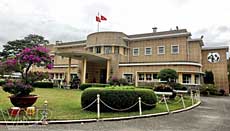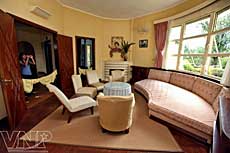Located on Trieu Viet Vuong Street, Da Lat in Lam Dong Province, Bao Dai's Palace is a charming structure with a European renovated architectural style that helps beautify this romantic city.
 The old palace, also known as Palace III, belonged to King Bao Dai, the last emperor of the Nguyen Dynasty (1802-1945) in Vietnam's feudal regime. It was built from 1933 to 1938 according to a design by a French architect and Vietnamese architect Huynh Tan Phat. The palace has been evaluated as one of the most beautiful architectural works in Da Lat with a hamorny between pine forests and parks, Thuong Uyen (royal garden), Ai An Forest and a small lake. During his reign, King Bao Dai used the palace as holiday house during the summer. During his holidays in the palace, there were always a regiment of imperial guards, a train of cars called "Cong xa biet dien" and private airplanes to serve him and his family. In 1948, when the French persuaded Bao Dai to serve as “head of state†and then established "Hoang trieu Cuong tho" ( Domaine de la Couronne in French) in 1950, Bao Dai's Palace was renamed "Biet dien Quoc truong" (the palace of the head of state).
The old palace, also known as Palace III, belonged to King Bao Dai, the last emperor of the Nguyen Dynasty (1802-1945) in Vietnam's feudal regime. It was built from 1933 to 1938 according to a design by a French architect and Vietnamese architect Huynh Tan Phat. The palace has been evaluated as one of the most beautiful architectural works in Da Lat with a hamorny between pine forests and parks, Thuong Uyen (royal garden), Ai An Forest and a small lake. During his reign, King Bao Dai used the palace as holiday house during the summer. During his holidays in the palace, there were always a regiment of imperial guards, a train of cars called "Cong xa biet dien" and private airplanes to serve him and his family. In 1948, when the French persuaded Bao Dai to serve as “head of state†and then established "Hoang trieu Cuong tho" ( Domaine de la Couronne in French) in 1950, Bao Dai's Palace was renamed "Biet dien Quoc truong" (the palace of the head of state).
Bao Dai's Palace was designed with 25 rooms with a system of well-disposed flat roofs. After entering the main gate is the great hall with eaves to shade the car park. The ground floor was used for parties and meetings with foreign guests and government officials. The palace also includes working rooms, King Bao Dai's office, a library, rooms for entertainment and a large dining room. The working room was designed with small architectural miniatures to create a hamonious combination between the living space inside and nature outside through doors and steel framed windows. At present, in the reception room many precious objects of King Bao Dai are displayed, including a painting on Angkor Wat presented by Cambodian King Shihanouk, and three tiger skins and an elephant's tusk hunted by himself.
 The first floor of the palace was used as the private space of the royal family with bedrooms of King Bao Dai and his wife, Queen Nam Phuong, and their three daughters and two sons. Near the bedroom of the king stands a beautiful tower called Vong Nguyet (waiting for the moon). The bedroom of Prince Bao Long who was selected to ascend the throne was painted yellow and all decorations have the same colour.
The first floor of the palace was used as the private space of the royal family with bedrooms of King Bao Dai and his wife, Queen Nam Phuong, and their three daughters and two sons. Near the bedroom of the king stands a beautiful tower called Vong Nguyet (waiting for the moon). The bedroom of Prince Bao Long who was selected to ascend the throne was painted yellow and all decorations have the same colour.
Outside, to the right of the main gate and in the back of the palace are small parks with a style often seen in French palaces. Around the palace are small paths shaded by pipe trees.
When visiting the palace, tourists will feel the solemn, close and warm space of the palace where imprints of a historical character, the last king of the feudal regime that existed for over thousands of years in Vietnam, are preserved.